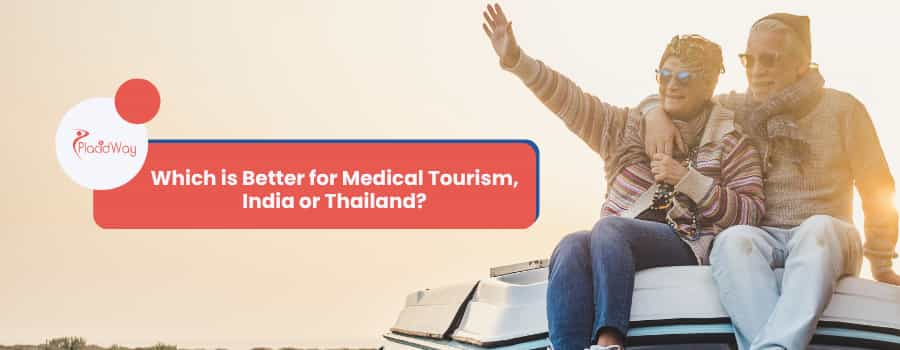How Does Medical Tourism in India Compare to Thailand?

Deciding where to go for medical treatment abroad is a significant decision, and making an informed choice for your overseas medical journey is critical. Two of the most popular destinations for medical tourism are India and Thailand. Both countries have carved out a niche for themselves in the global healthcare market, but they offer different experiences. So, which one is better for you? The answer isn't straightforward and depends on what you value most, whether it's cost, the overall experience, or specific medical expertise.
India has emerged as a leader in providing high-quality, affordable medical care, particularly for complex procedures like cardiac surgery and organ transplants. With a vast network of internationally accredited hospitals and a large pool of highly skilled, English-speaking doctors, India presents a compelling case for those seeking specialized treatments without breaking the bank. The cost savings can be substantial, often up to 90% compared to the US and UK.
On the other hand, Thailand is the undisputed heavyweight of the medical tourism industry in terms of patient volume. It masterfully blends top-notch medical care with a world-class tourism infrastructure. Thailand is renowned for its cosmetic surgery, dental work, and wellness retreats. While slightly more expensive than India, it offers a seamless and often luxurious experience, with many hospitals feeling more like 5-star hotels. This makes it an attractive option for those who want to combine medical treatment with a relaxing vacation. This guide will walk you through a detailed comparison to help you choose the destination that best fits your needs.
What is the primary difference between medical tourism in India and Thailand?
When you're weighing your options for choosing between India and Thailand for surgery, understanding the core strengths of each country is crucial. India's main draw is its ability to offer highly specialized medical procedures at some of the lowest prices in the world. This has made it a go-to destination for patients needing critical surgeries like heart bypasses, organ transplants, and orthopedic procedures. The focus is squarely on the medical outcome, with world-class hospitals and surgeons dedicated to providing the best possible care.
Thailand, in contrast, has built its reputation on the overall patient experience. It's a country that has long been a major tourist destination, and it has expertly translated this into its healthcare sector. Thai hospitals, especially the private ones catering to international patients, are known for their luxurious amenities, excellent service, and a holistic approach to care. This makes Thailand a top choice for elective procedures like cosmetic surgery, where the supportive recovery environment after plastic surgery is just as important as the procedure itself.
How do the costs of medical procedures compare between India and Thailand?
Cost is often the most significant factor for people comparing healthcare costs for medical tourists. Both India and Thailand offer substantial savings compared to countries like the US and UK, but there's a noticeable price difference between them. India is widely recognized as one of the most cost-effective destinations for high-quality medical care. For major surgeries, the price difference can be staggering. For example, a heart bypass surgery that could cost over $100,000 in the US can be done for as little as $5,000 in India.
Thailand, while still very affordable, tends to be slightly more expensive than India. The higher price point is often justified by the premium services and all-inclusive medical packages that many Thai hospitals offer. These packages often bundle the medical procedure with accommodation, transportation, and even tourism activities, providing a hassle-free experience. Here's a look at the cost of knee replacement in India vs Thailand and other common procedures:
| Procedure | Cost in India (USD) | Cost in Thailand (USD) | Approximate Cost in the US (USD) |
|---|---|---|---|
| Heart Bypass Surgery | $5,000 - $8,000 | $15,000 - $25,000 | $70,000 - $150,000 |
| Knee Replacement | $4,000 - $9,000 | $8,000 - $12,000 | $30,000 - $50,000 |
| Hip Replacement | $5,000 - $10,000 | $7,000 - $12,000 | $40,000 - $60,000 |
| Rhinoplasty (Nose Job) | $1,500 - $4,000 | $3,000 - $5,000 | $6,000 - $10,000 |
| Dental Implants (per tooth) | $500 - $1,500 | $2,000 - $3,000 | $3,000 - $4,500 |
What is the quality of healthcare and hospitals in India and Thailand?
When it comes to the quality of care, both India and Thailand have invested heavily in their healthcare infrastructure to attract international patients. A key indicator of quality is accreditation from the Joint Commission International (JCI), a US-based organization that is considered the gold standard in global healthcare. For patients finding top JCI accredited hospitals in Asia, both countries have a substantial number of options, which means they adhere to the same high standards of safety and quality as top hospitals in the West.
Thailand has one of the highest numbers of JCI-accredited hospitals in the world, with over 60 facilities meeting these rigorous standards. This is a testament to the country's commitment to providing world-class medical care. India also has a growing number of JCI-accredited hospitals, with many of them being part of large, reputable hospital chains like Apollo and Fortis. These hospitals are equipped with the latest technology and staffed by highly trained and experienced medical professionals.
- India: Known for its large, multi-specialty hospitals that are centers of excellence for specific treatments. For example, some hospitals are renowned for cardiology, while others specialize in oncology or orthopedics.
- Thailand: Many of its top hospitals are full-service institutions that offer a wide range of treatments under one roof. They are also known for their international patient support services, which provide comprehensive assistance.
Which country is better for cosmetic surgery?
If you're considering the best destination for plastic surgery abroad, Thailand is often the first country that comes to mind. It has built a stellar reputation in this field, attracting patients from all over the world for procedures like breast augmentation, facelifts, and rhinoplasty. The country's surgeons are highly skilled and experienced, and the clinics are equipped with the latest technology. Moreover, the serene and beautiful environment of Thailand makes it an ideal place for cosmetic surgery recovery in Thailand.
India is also a strong contender for cosmetic surgery, and its main advantage is cost. You can get affordable high-quality cosmetic procedures in India for a fraction of the price you would pay in Thailand or the West. While it may not have the same "glamorous" reputation as Thailand for cosmetic surgery, the quality of care is excellent, and the savings can be significant. Ultimately, the choice may come down to your budget and your preferences for the overall experience.
What about cardiac surgery and other complex procedures?
For major, life-saving surgeries, India has a distinct advantage and is often considered the best country for affordable cardiac surgery. The country has a large number of "centers of excellence" that specialize in complex procedures. These hospitals have a high volume of patients, which means the surgeons have a great deal of experience and expertise. The success rates for procedures like heart bypass surgery and organ transplants in India are on par with the best hospitals in the world.
While Thailand also has excellent hospitals that can perform complex surgeries, it's not as well-known for this as India. The costs for these procedures are also generally higher in Thailand. Therefore, if you're seeking a highly specialized, complex surgery like finding specialized neurosurgery hospitals abroad, India is likely to be the more practical and affordable choice.
How do the visa processes for medical tourists compare?
Both India and Thailand have made it relatively easy for medical tourists to obtain visas. They both offer a specific "Medical Visa" category, which is designed for this purpose. The general requirements for both countries are quite similar:
- A valid passport
- A letter from a recognized hospital in India or Thailand, confirming the need for treatment and the appointment details.
- Proof of sufficient funds to cover the cost of treatment and stay.
When understanding the medical visa process for India, know that it can be granted for up to a year and can be extended if necessary. It also allows for up to two attendants to travel with the patient. Thailand's medical visa typically allows for a stay of 60-90 days and can also be extended. While both processes are well-established, some patients report that Thailand's visa process is slightly more straightforward and quicker.
What is the overall patient experience like in each country?
The patient experience is where Thailand truly shines. The country's culture is deeply rooted in hospitality, and this extends to its healthcare sector. Private hospitals in Thailand are often compared to luxury hotels, with beautiful facilities, private rooms, and a wide range of luxury hospital amenities in Thailand. The staff are known for their warmth and attentiveness, and many hospitals have dedicated international patient departments to assist with everything from language interpretation to travel arrangements.
In India, the focus is more on the clinical aspect of care. While the medical treatment is world-class, the patient experience in Indian hospitals can be more "no-frills" compared to Thailand. The hospitals are clean and modern, but they may not have the same level of luxury. However, the care is compassionate and professional, and the English proficiency of medical staff is generally very high. For patients who are primarily concerned with the quality of the medical treatment and the cost, India is an excellent choice.
What are the opportunities for tourism and recovery?
One of the major benefits of medical tourism is the opportunity for planning a recovery vacation after surgery in Asia. Both India and Thailand are incredible tourist destinations in their own right. Thailand is famous for its stunning beaches, vibrant cities, and delicious food. Popular recovery spots include the islands of Phuket and Koh Samui, where you can relax in a tranquil setting after your procedure.
India offers a much more diverse range of experiences. You can explore the historical monuments of Delhi and Agra, the backwaters of Kerala, or the spiritual city of Varanasi. For those seeking a more wellness-focused recovery, India is the birthplace of Ayurveda and yoga, and there are many wellness tourism opportunities in India that offer these traditional healing practices. The choice between the two will depend on your personal interests and the kind of environment you find most relaxing.
What about language and communication?
One of the common concerns for medical tourists is the language barrier. However, in both India and Thailand, this is rarely an issue when it comes to communication with doctors in foreign hospitals. India has a large English-speaking population, and English is one of its official languages. All doctors and most medical staff in private hospitals are fluent in English.
In Thailand, while Thai is the official language, the medical tourism industry is well-equipped to handle international patients. Doctors and nurses in major hospitals are proficient in English, and many hospitals also have interpreters available for other languages. You can expect clear and effective communication about your treatment and care in both countries.
Which country has better success rates for fertility treatments?
For couples seeking fertility treatments, both India and Thailand are excellent options. They have modern fertility clinics with advanced technology and experienced specialists. The IVF treatment success rates in India vs Thailand are comparable to those in the US and Europe, typically ranging from 30-40% per cycle, depending on the patient's age and other factors.
India is often more affordable for IVF and other fertility treatments. However, it's important to be aware of the legal aspects of international surrogacy, as regulations can be complex. Thailand also has a thriving fertility tourism sector, but it has stricter laws. For example, commercial surrogacy is banned for foreigners. It's crucial to do thorough research and choose a reputable clinic in either country.
Choosing between India and Thailand for medical tourism is a personal decision that depends on your unique needs and priorities. By considering the factors outlined in this guide, you can make an informed choice that is right for you.
Ready to explore your options for medical tourism? Visit PlacidWay to find accredited hospitals, get free quotes, and plan your medical journey with confidence.


.png)














Share this listing